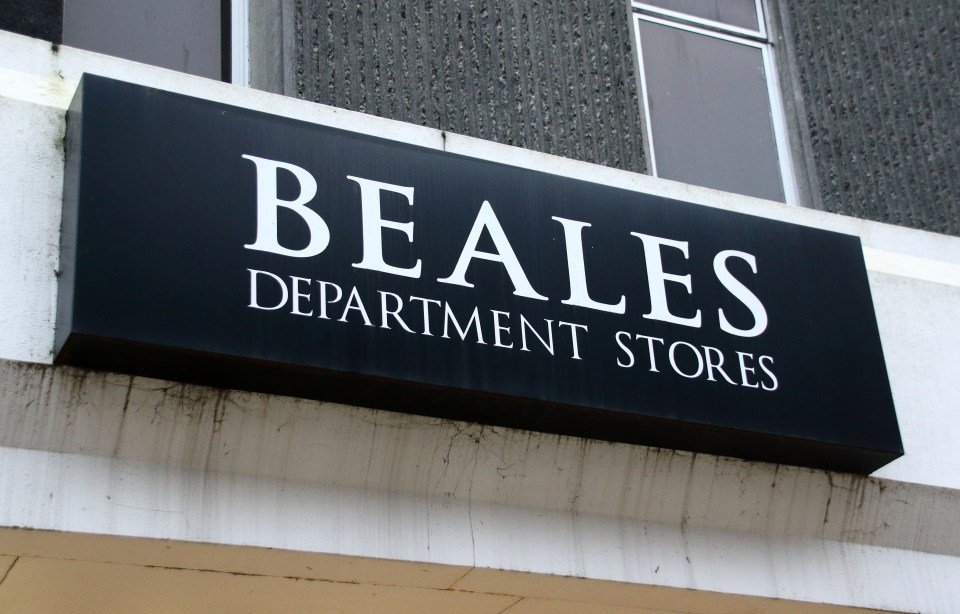Iconic department chain to shut final store this MONTH & vanish forever as it launches ‘Rachel Reeves closing down sale’
A BELOVED department chain is preparing to shut its final store this month as it launches a “Rachel Reeves closing down sale.”
The famous shop will be shuttering forever after serving customers on the high street for 140 years.
Beales in the Dolphin Centre in Poole will close on May 31 and is slashing the price of stock by 80 per cent in the meantime.
The historic chain was founded in Bournemouth in 1881 and offers a range of iconic products, including clothing, home goods, and more.
This particular Poole Beales branch was the last one standing when the company collapsed into administration in January 2020, leading to the closure of its 22 other stores.
Despite the stores resilience, the brutal budget introduced last year saw the hike of National Insurance which has forced countless shops to close.
To mark the occasions, the store’s Facebook page is advertising a “Rachel Reeves‘ Closing Down Sale,” featuring discounts of up to 80% and a caption cheekily thanking the Chancellor for “the help.”
It wrote in the caption: “Our closing sale is almost over (cheers for the help, Chancellor) – and we’ve just dropped hundreds of lines to 80% OFF or more!
“Grab a bargain before we vanish into the budget black hole. #FinalSale #80Off #LastChance #WhenItsGoneItsGone.”
Despite weathering the storm for the past five years, it seems the Chancellor’s latest Budget changes have delivered the final blow to the struggling chain.
Beales chief executive Tony Brown previously told The Telegraph the business had become “unviable” following the Chancellor’s announcement of increases to the minimum wage and national insurance contributions in the October Budget.
Announcing the closure, Mr Brown said: “This, combined with the risks and uncertainty of further tax increases in the coming years, has left us with no alternative.
“We have been working with the Dolphin Centre, who have been supportive, along with our investors to ensure an orderly exit.
“Our team has been informed, as have our suppliers.
“We will ensure the exit is managed and no one will be left with a financial loss.”
Shoppers were left heartbroken by the news of the store’s impending closure, with one commenting on the latest post: “I’ve loved shopping here over the years.”
Another wrote: “Sadly this is happening to many shops.”
Like many businesses, Beales now faces higher employer national insurance contributions, which have risen from 13.8% to 15%.
Additionally, the threshold at which these contributions must be paid has been lowered from £9,100 to £5,000.
These changes to the tax system were confirmed by the Chancellor in the Autumn Budget last October and came into effect on 1 April.
At the same time, the national minimum wage saw a notable increase, rising to £12.21 per hour. For workers aged 18-20, the minimum wage increased by £1.40 to £10 per hour.
Founded in 1881, Beales once boasted a proud portfolio of 41 department stores in market towns across the UK, offering everything from furniture and fashion to toys and cosmetics.
The retailer’s decline has been gradual but unrelenting.
Its Southport store was shuttered last September, just three years after the site had reopened.
With the closure of the Poole branch, the last remaining link to the Beales name, a once-iconic fixture of the British high street, will vanish forever.
DEATH OF THE HIGH STREET
Retailers have been feeling the squeeze since the pandemic, while shoppers are cutting back on spending due to the soaring cost of living crisis.
High energy costs and a move to shopping online after the pandemic are also taking a toll, and many high street shops have struggled to keep going.
However, additional costs have added further pain to an already struggling sector.
The British Retail Consortium has predicted that the Treasury’s hike to employer NICs from April will cost the retail sector £2.3billion.
At the same time, the minimum wage will rise to £12.21 an hour from April, and the minimum wage for people aged 18-20 will rise to £10 an hour, an increase of £1.40.
Experts have said small high street shops could face a particularly challenging 2025 because of Budget tax and wage changes.
Professor Bamfield has warned of a bleak outlook for 2025, predicting that as many as 202,000 jobs could be lost in the sector.
“By increasing both the costs of running stores and the costs on each consumer’s household it is highly likely that we will see retail job losses eclipse the height of the pandemic in 2020.”
Why are retailers closing shops?
EMPTY shops have become an eyesore on many British high streets and are often symbolic of a town centre’s decline.
The Sun’s business editor Ashley Armstrong explains why so many retailers are shutting their doors.
In many cases, retailers are shutting stores because they are no longer the money-makers they once were because of the rise of online shopping.
Falling store sales and rising staff costs have made it even more expensive for shops to stay open.
The British Retail Consortium has predicted that the Treasury’s hike to employer NICs from April 2025, will cost the retail sector £2.3billion.
At the same time, the minimum wage will rise to £12.21 an hour from April, and the minimum wage for people aged 18-20 will rise to £10 an hour, an increase of £1.40.
In some cases, retailers are shutting a store and reopening a new shop at the other end of a high street to reflect how a town has changed.
The problem is that when a big shop closes, footfall falls across the local high street, which puts more shops at risk of closing.
Retail parks are increasingly popular with shoppers, who want to be able to get easy, free parking at a time when local councils have hiked parking charges in towns.
Many retailers including Next and Marks & Spencer have been shutting stores on the high street and taking bigger stores in better-performing retail parks instead.
In some cases, stores have been shut when a retailer goes bust, as in the case of Carpetright, Debenhams, Dorothy Perkins, Paperchase, Ted Baker, The Body Shop, Topshop and Wilko to name a few.
What’s increasingly common is when a chain goes bust a rival retailer or private equity firm snaps up the intellectual property rights so they can own the brand and sell it online.
They may go on to open a handful of stores if there is customer demand, but there are rarely ever as many stores or in the same places.
The Centre for Retail Research (CRR) has warned that around 17,350 retail sites are expected to shut down this year.




